Inhalable particles for pulmonary delivery in tuberculosis
For several years, our lab has been asking the dumb question:
'if tuberculosis is primarily a lung disease, why is the patient made to
swallow medicines when they can be inhaled?' We therefore make and study
particles that can be inhaled and deposited in the deep lung. Spray-drying,
spray freezing, supercritical fluids, high-pressure homogenization and the
mortar-pestle are our favourite techniques.
We find that if we make TB-infected animals inhale about 80-100 micrograms of particles containing
anti-TB drugs every day for 3-4 weeks, their lungs are completely cleared of culturable bacteria.
Combining inhalations with half the standard oral doses clears extra-pulmonary sites of bacteria as well,
and there is no relapse even after an additional month of no treatment. We are now working on pulmonary delivery
of drug combinations used in the treatment of multi drug resistant TB, and trying to get our earlier formulations into
clinical trials.
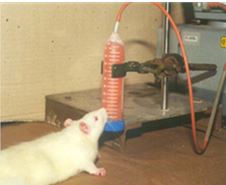

We also have evidence that inhaled particles are phagocytosed by lung macrophages, which they proceed to
'rescue'from alternative (M2) activation imposed by the TB bacteria as a fallout of co-evolved its survival strategy.
Transcriptome analysis indicates that ~700 genes are differentially regulated in human macrophages infected in vitro with
M. tuberculosis and treated either with anti-TB drugs in solution or with particles containing equal amounts of the same drugs. We have also found that up to 15 proteins of M. tuberculosis localise to the nucleus of the human macrophage, despite the absence of a nuclear localisation signal. We have a hunch that these proteins cross the nuclear membrane by means of protein-protein interactions with host molecules. Some of these nuclear proteins have DNA-binding motifs. We would not be surprised if these proteins mediate host-pathogen interactions at the level of host gene transcription.
We are also working on elements of the host defence response by infected macrophages using inhalable particles-- either as pharmacological inducers of appropriate responses (e.g. rapamycin for inducing autophagy) or effector molecules themselves (e.g. nitric oxide donors like the angina medicine isosorbide mononitrate); or as inhibitors of pathogen-evoked responses (e.g. siRNA to knock down Suppressors of Cytokine Signalling).
 Autophagy induced in the lungs of mice infected with TB upon inhalation of rapamycin (sirolimus)
Autophagy induced in the lungs of mice infected with TB upon inhalation of rapamycin (sirolimus)
Delivery systems for Glucagon-like Peptide-1 (GLP-1) for management of diabetes
GLP-1 is useful in both Type 1 and Type 2 diabetes mellitus and can maintain a healthy level of blood sugar if given by constant infusion at 1-1.25 pM/Kg/min. The peptide has a half life of ~5 min at unit dose levels of 2.5 to 25 nM or infusion at 0.5 pM/Kg/min. We are working on a once-a-month injection, confident that even a worst-case outcome of dose-dumping poses no risk of hypoglycemia, anorexia or other adverse effects from
dose dumping, since GLP-1 actions are either blood glucose-dependent or incretin receptor-mediated. Initial results in mie with an in-situforming gel are promising.
We are also studying inhalable particles containing the peptide, but unlike our particles for tuberculosis, these particles are designed to break up rapidly before they can be taken up by lung macrophages. Initial results indicate that diabetic mice receiving once-a-day inhalations of our ‘football-like’ particles can control of blood sugar if challenged with an intra-peritoneal dose of glucose.
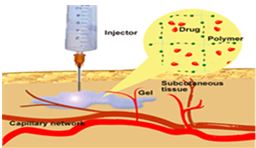

In situ gel, once-a-month
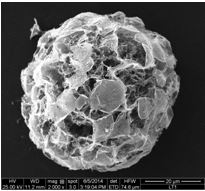
Inhalable ‘football’ for GLP-1 delivery
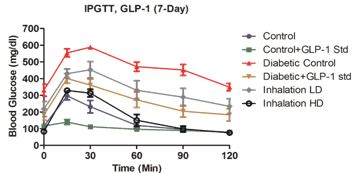
Intraperitoneal glucose tolerance at 7 days after 2.3- (grey curve) or 4.6µgdaily inhalation of GLP-1 (black curve) in mice
Targeting infected erythrocytes in malaria
Not more than 5-8% of red blood cells (RBC) are infected in malaria. Infected RBC (iRBC) need more glucose than healthy RBC, and so have more glucose transporter proteins (GLUT-1) on their surface. Plasmodium also inserts its own hexose transporter (PfHT-1) into the iRBC membrane. We make particles containing anti-malarial drugs, chloroquine and CDRI candidate 97/63, using cheap biocompatible material like starch and chitosan, sometimes derivatising chitosan with ligands that can bind GLUT-1 and PfHT-1. Not surprisingly, the effective dose falls dramatically when we test these particles in a human RBC culture of the malaria parasite.
Male Contraception
In collaboratin with IIT Kanpur, we built a computation model of the axis of reproductive hormones secreted by the hypothalamus in the brain, the pituitary gland and the testes. The secretion of these hormones is episodic, and the downstream hormone testosterone exercises feedback inhibition on the secretion of upstream hormones. Arguing that episodic intervention with testosterone is necessary and sufficient to inhibit the secretion of brain and pituitary hormones, we made transdermal delivery systems for pulsatile delivery of testosterone. In silico and in vivo, these patches demonstrated negative regulation of male fertility in rats.
 Representativesections of testicular tissue at day 71 from a normal rat (Left) showing Stage VII developing sperm, a sham-treated control (Centre) with Stage XI and a treated animal (Right) exhibiting Stage VIII-sloughing of germ cells and tubular contents from seminiferous epithelium. Magnification-40X for control and sham and 20X for T-treated.
Representativesections of testicular tissue at day 71 from a normal rat (Left) showing Stage VII developing sperm, a sham-treated control (Centre) with Stage XI and a treated animal (Right) exhibiting Stage VIII-sloughing of germ cells and tubular contents from seminiferous epithelium. Magnification-40X for control and sham and 20X for T-treated.
Female contraception
The presence of a foreign body in the uterus is most often contraceptive. We made biodegradable particles that could travel across the cervix and into the uterus if instilled into the vagina. Mice receving intravaginal instillations of a suspension of these particles upregulated pro-inflammatory cytokines such as RANTES in the uterus. We expect that these conditions would hinder implantation of fertilised embryos.
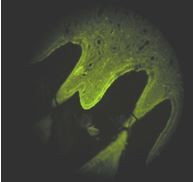
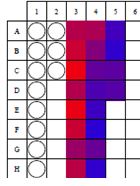
(Left): Fluorecent particles reach the uterus and light up its walls if instilled into the vagina (Right):The presence of particles up-regulates inflammation markers in the lavage obtained from the uteri of treated animals (red) but not animals receiving only saline (blue)